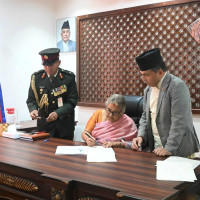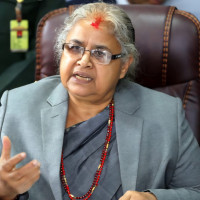- Sunday, 14 September 2025
Jhula festival begins in Mithila
By Laxmi Chaudhary-Nagendra Kumar Karna
Janakpurdham/Mahottari, Aug. 2: The temples of Janakpurdham are decked in flowers and colourful lights to mark the grand Jhula festival. Lasting 13 days from the third day of the bright lunar fortnight of the month of Shrawan to the full moon day, the festival began this year on Sunday and the people all over the city are celebrating it by placing the idols of Ram and Janaki on swings and swinging them in a ritualistic manner.
Janaki Temple has been specially decorated and wears a soothing blue and purple glow every evening. Here, priests and devotees put the statues of Ram and Sita on a throne and swing it.
The Jhula festival begins right after the planting season and after the Madhushravani fast ends. In addition to swinging, folk songs like the Kajari and Malar are also sung. People also dance, stay up late into the night and stage the Ram Leela.
Scholars believe that the Jhula festival was started in Janakpur by one Surkishor Das in 1730. Das is a saint of the Ramanandi sect of Hinduism and came to the city from the Galata shrine of Jaipur, India. Although Das belonged to the Ramanandi sect, he held great reverence for the Rasik cult and swung Sita with a feeling of paternal love.
To establish a bond, those who belong to the Rasik cult usually form a family relationship with their guardian gods. This is what prompted Das to build a father-daughter relationship with Goddess Sita. This also established a tradition of the Mahanthas (priests) of the Janaki Temple worshipping Sita as their daughter; a tradition that continues to this day.
“This is a unique bond between the deity and devotee,” said religious scholar Pradeep Datta, who added that the structural and cultural foundation of Hinduism was strengthened during Das’s time.
According to Hari Prasad Mandal, Mayor of Matihani Municipality, Mahottari, the first day of Jhula is dedicated to the Mani Parvat which was the hill formed from the gems Ram and Sita received as dowry from Sita’s side during the marriage.
The legend goes that there were so many gems (Mani) that there was no space to keep them all in the royal palace. Hence, they had to be piled outside but the pile was so big that it formed a hillock.
As with Ram and Sita, the people of Mithila also celebrate the Jhula festival for Radha and Krishna in this period. This, experts believe, represents a pragmatic unity between the saints who give up worldly pleasures and normal people immersed in their earthly lives.
















